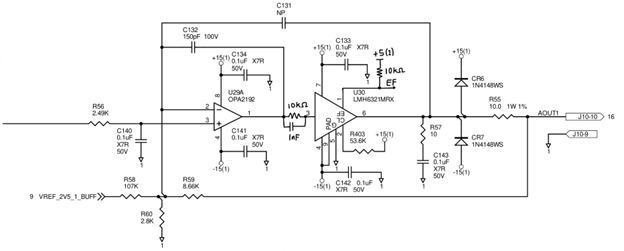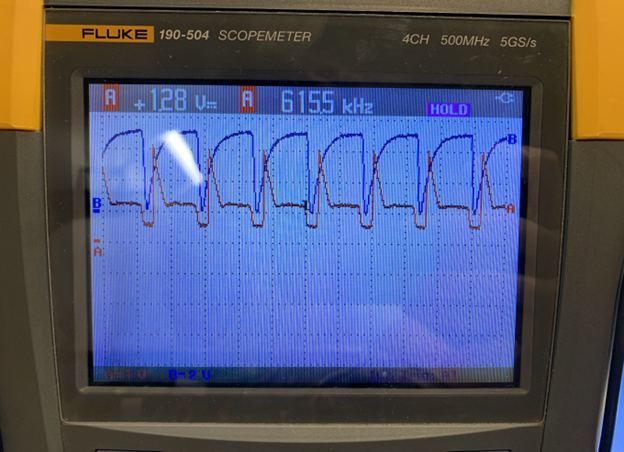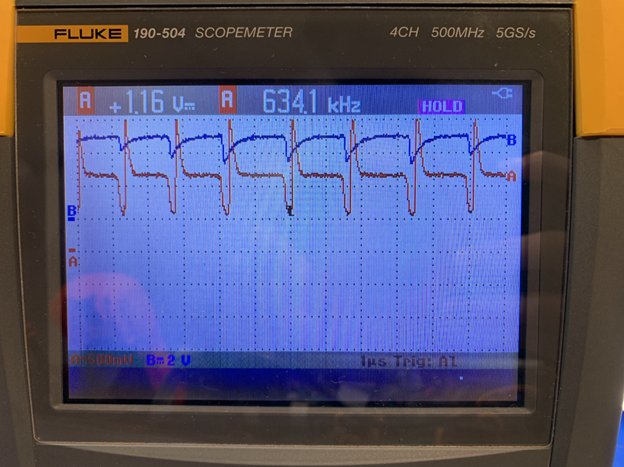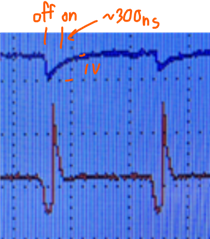Other Parts Discussed in Thread: OPA192
Tool/software:
Hello!
I am using the LMH6321 in the following design:

I input a 0 - 2.5V signal from the left and at the output I get a -0.2 - 10.2V signal. Using the 53.6kΩ resistor I am setting an approximate 120mA current limit. Fortunately, these parts of the circuit seem to work as anticipated.
Unfortunately, what doesn't work is the EF pin, as you can see in the schematic diagram I have inserted in a 10kΩ resistor which pulls EF up to +5V. During normal operation, I get the expected +5V output at this pin. However, under an overheat condition (introduced by either a short circuit or heat gun) the EF pin begins to oscillate:

Note that the EF pin 1 is the blue trace, and the output pin 6 is the red trace. The IC is sourcing roughly 120mA into a short connected to the output through the 10Ω resistor. If I continue to heat the IC up with a heat gun the oscillation changes period and frequency:

By measuring the voltage across R55, the 10 Ω output resistor, we can measure output current. The blue trace is the EF pin, and the red trace is the output current at a scale of 50mA per division.

If the IC is heated without a load similar behavior on the EF pin occurs. If the IC is heated enough (does not occur during normal conditions, must use heat gun for an extended period of time) then the EF pin finally goes to ~0V, but as soon as the heat is removed it almost immediately goes back to +5V. Here are a few things I tried:
- Replacing the IC to ensure it wasn’t damaged. No change in behavior.
- Adding a capacitor (1nF or 100nF) to the EF pin. This stopped the oscillation but clearly was covering up the issue, the EF pin had an analog voltage on it that varied with how much heat the IC was exposed to.
- Added larger 10uF ceramic decoupling capacitors and thick 24AWG solid core wire to connect all grounds together and to supply ground. No change in behavior.
- Used +3.3V instead of +5V to pull up EF pin. No change in behavior.
- Removed 1nF capacitor between OPA192 output and LMH6321 and replaced resistor with 5.1kΩ instead of 10kΩ. No change in behavior.
- Tried a different variant of this IC. I noticed we had some older LMH6321 that did not have a pin 1 dimple and slightly different etching on the top, so I tried using one of these to see if there was a change that affected the behavior of the EF pin. No change in behavior.
I read the datasheet, and the EF pin has a 10°C hysteresis so I am surprised that I am seeing this oscillation and that it snaps back so quickly when heat is removed. Here is a snapshot of the layout for what it’s worth. Keep in mind that the EF pin pullup and the series 10kΩ/1nF resistor capacitor combo have been modded-in by me.
Red is the top layer and the vias all connect the exposed pad to a -15V plane. We make another device that uses the LMH6321 and I tried using the EF pin in this design (which had a different layout) and it still exhibited this oscillatory behavior but at a lower frequency.
I was wanted to use the EF pin to tell the main MCU that a fault has occurred but due to this phenomena that doesn’t seem like it will work. What is going on here? What is the expected behavior of the EF pin?
Thanks!



